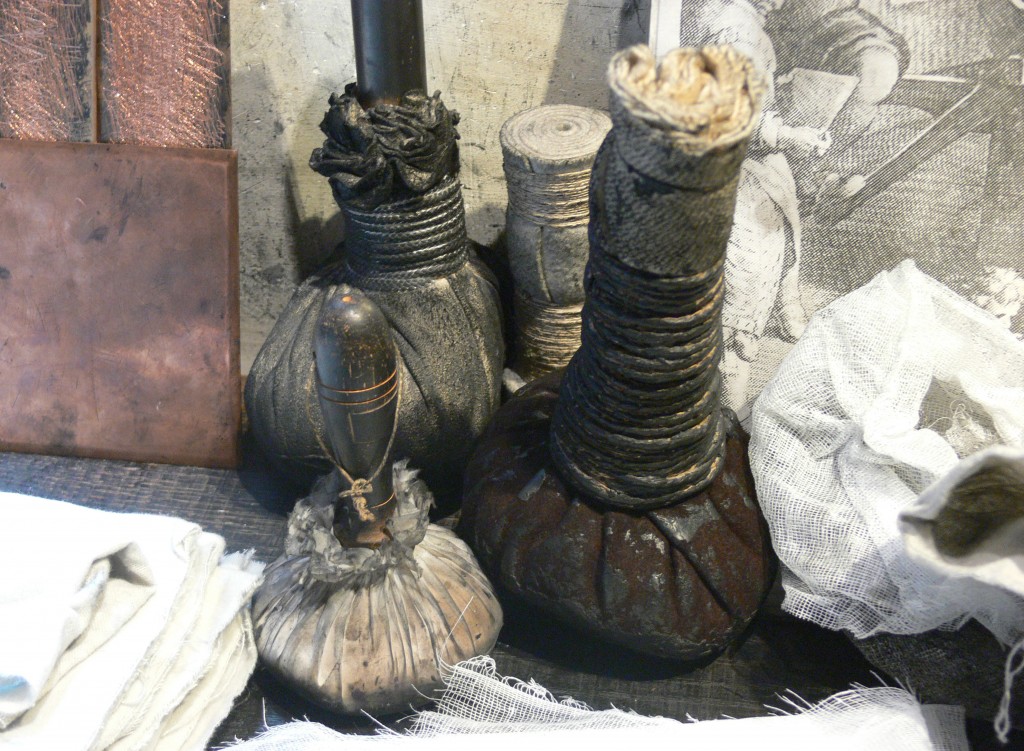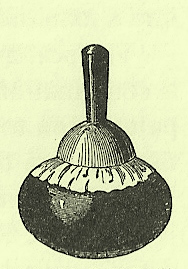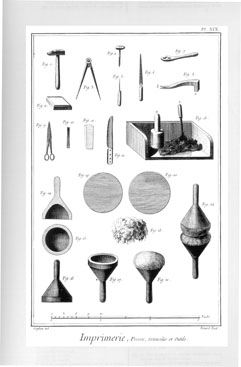Up until the mid 19th century ink balls (also commonly called dabbers or inking balls) were used to apply ink to letter presses and in print making. An ink ball was made of sheepskin, inside of which wool or horsehair was placed, and a wooden handle. The finished product looks something like a pestle or a muller used for grinding paints. The ink was applied to the outside of the sheepskin before it was applied to a letterpress.
 (http://en.wikipedia.org/wiki/Ink_ball)
(http://en.wikipedia.org/wiki/Ink_ball)
When being used for printmaking a single ink ball would be used to get the consistency of the ink right. When being used for letter-pressing two ink balls would be used. Ink would be applied only to one of the ink balls and then the ink would be rubbed between the two of them to get the right consistency on the movable type. A worker placed the movable type manually into the printing press where he would coat the type with the ink. The person applying the ink would have to “beat” the ink onto the type to apply it. After the ink was applied a slightly damp blank piece of paper was inserted into the printing presses tympan. The worker would lower the blank paper against the freshly inked type. Using a hand crank, the printer would roll the print and paper under a large press and press the ink into the paper. The printer would do this many times a day, re-inking each time.
 (http://britishletterpress.co.uk/letterpress-guides/printing/early-rollers-and-composition-rollers/)
(http://britishletterpress.co.uk/letterpress-guides/printing/early-rollers-and-composition-rollers/)
The use of ink balls began to decline in the 19th century with the advent of the composition roller. These rollers looked much like the rollers used for painting projects today. Composition rollers were made from a mixture of glue and molasses or other sugar substances. Using rollers for inking had been attempted before but no substance could be found that spread the ink as evenly as ink balls. In the early 1800s an Englishman named Robert Harrild discovered the glue and sugar composition. While the use of the composition rollers was more convenient they came with their own set of problems. Rollers made during certain times of year would become unusable in different seasons as they would dry out and shrink so the recipe for a composition roller changed based on what time of year it was made.
 (http://quod.lib.umich.edu/d/did/did2222.0001.562/–letterpress-printing?rgn=main;view=fulltext;q1=donaldson)
(http://quod.lib.umich.edu/d/did/did2222.0001.562/–letterpress-printing?rgn=main;view=fulltext;q1=donaldson)
While use of ink balls has declined since the invention of modern day printing methods it has not completely died out. In fact there has been a revival of sorts in the use of traditional printing presses. Many colleges now offer courses or extracurricular in letterpress printing through their Schools of Art or their libraries. In 2006 Abigail Uhteg founded The College & University Letterpress Printers’ Association, CULPA, so that letterpress printers in these collegiate programs could stay connected.
To see a letterpress, using a composite roller, in action click here (http://goo.gl/GzREGf)
By Ethan Weston, Volunteer Contributor

